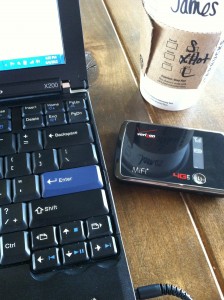
It’s no secret that every day our lives are revolving more and more around our mobile devices. Phone calls, e-mails, Facebook stalking & streaming those classic Bowie hits – what would we do without it? We would probably be a much more polite, productive, better communicating society. Who wants that though? This blog is about directing you to a wireless carrier that’ll keep your “lets dance†Pandora station streaming hiccup free here in the Stumptown sippin’, hipster capital of America.
Let’s break it down. Here in the US there are four major carriers to choose from: T-Mobile, AT&T, Sprint, & Verizon. All four carriers can be split into two major groups based on the technology they use for transmitting & receiving their 1’s & 0’s – Global System for Mobile Communications (GSM) and code division multiple accesses (CDMA). T-Mobile and & AT&T are both GSM, while Sprint & Verizon are CDMA. GSM has been around the longest and is the world standard for mobile communications with almost every country utilizing it. CDMA is newer, and unlike the rest of the world, is the dominant cellular technology here in the US.
In the past the major reason you would seek out a GSM based carrier could very easily be summed up: world travel. Because the entire world uses GSM, you could take your AT&T or T-Mobile phone anywhere in the world and roam on other providers networks. Things have slightly changed recently though as many feature phones now include both CDMA & GSM radios.
While a GSM phone will allow you to freely roam the earth, it can also break the bank. If you plan on traveling & are interested in saving money on international roaming look into buying a pre-paid SIM card for the particular country you’re planning to visit. A SIM (subscriber identity module) is a swappable card used in GSM devices that store your account information and is used to identify & authenticate you with the wireless network. This gives you the freedom to take your phone number and service to any mobile device simply exchanging the SIM card.
Prepaid SIM cards come with a new local telephone number that will allow you get on Yelp for the best schnitzel Germany has to offer without stressing about super high roaming/data fees. The downside with prepaid SIMS is friends & family will no longer be able to reach you with your local US number. That’s ok though because with or without a prepaid SIM international long distance rates fall into ridiculous territory with prices as high as $3.00 a minute. If you want to reach out back home look for a café that offers free WIFI and send an e-mail or use a VOIP solution like Skype.
For those of us that don’t do much traveling and actually use our phones as phones the biggest reason to go CDMA over GSM: fewer dropped calls. It’s not just because Sprint & Verizon cast a larger net, but how CDMA actually handles your phone calls. When you’re placing a call on a Verizon phone it’s connected with multiple towers at the same time, utilizing the one with the best reception, so if one tower drops off you don’t lose the call. GSM only handles one tower at a time with no overlap which results in a higher percentage of dropped calls. People refer to it as a “soft hand-off†vs. a “hard hand-off.†Other benefits of CDMA include: increased call clarity (background noise filtration), less radiation – 28 times less found in this study, and far better security.
So CDMA seems to have its advantages in many different areas, but what carrier is covering the Beaver State the best? The winner without contest is big red. That’s Verizon to the layperson. AT&T’s & T-Mobile’s coverage in Oregon’s more rural areas leaves a lot to be desired. GSM coverage on Highway 26 on the way to the coast is painful to look at – endlessly cycling in and out of service like Rosie O’donnell trying to choose just one flavor at Baskin Robins. The highly populated urban areas aren’t much better. With an AT&T iPhone 3GS I once dropped the same phone call three times in the span of ten minutes traveling up I-5 from the Tualatin area. My client on the other end inquired, “Are you having some issues with your phone?†I looked down. My phone said I had five bars. And that was the end of my brief affair with AT&T.
If you’re someone that never makes phone calls and would rather text the person sitting next to you than have an actual conversation, T-Mobile is a smart way to go. It’ll have pretty much the same coverage as AT&T, but with cheaper package options.
What about Sprint? It’s true that Verizon & Sprint have roaming agreements and in many of cases have the same coverage. It’s also true that Sprints packages have truly unlimited data as well as cheaper plans when compared to AT&T and Verizon. The problem for me with Sprint lies in its 4G service.
As you may know 4G service is all the rage now, blowing the doors of its older, slower 3G sibling. Sprint was the first to the market with a true 4G solution using WiMAX. As soon as it was out I was one of the first people to jump on board. It was very exciting to see download speeds in excess of 15 Mbps with upload speeds averaging 1 Mbps. For perspective the average Comcast customer usually averages 25-30 Mbps down & 4-5 Mbps up. Previous to that the average download speed you would get from Verizon, Sprint, or AT&T over 3G was between 800 Kbps and 1.5 Mbps, so it was certainly a huge improvement.
There were some 4G coverage dead spots in rural areas which I expected, but I was a little stunned with some of the metropolitan areas of Beaverton & Hillsboro that didn’t have coverage. It wasn’t the end of the world though because at least I could get these new silly speeds in some parts of Oregon. Besides, what other 4G option did I have?
That is until Verizon unleashed ludicrous speed with its new fancy 4G LTE service. Like a man sobering up, I realized Sprint’s network wasn’t as attractive as previously thought. With my 3G/4G LTE hotspot from Verizon everywhere that I didn’t have 4G service with Sprint I was getting full bars with Verizon. Not only that, but the upload & download speeds absolutely crushed (as high as 30Mbps down & 20Mbps up in some parts) Sprint’s offerings. I was even getting Verizon’s fastest way out in the middle of nowhere in Oregon City. To this day I think there might be only one place I’ve been, besides the coast, where my hotspot has had to hobble along at the slower 3G speeds. So it’s really not that Sprint’s 4G service is so bad, but that Verizon’s is so much better.
So in Oregon Verizon has the fastest/largest 4G network, best 3G coverage, and overall better call quality than it’s GSM competition. What’s left to know? Well, what most people aren’t aware of is that the experience they have with a wireless carrier has a lot to do with the equipment they use. While Verizon does an excellent job of testing each device that it approves for its network, there are some devices that eclipse others.
If you’re the average consumer in the market looking for a smartphone on Verizon network, you can’t go wrong with Apple’s iPhone 4S. It gets great reception and it’s still the most intuitive smartphone on the market by a mile. Battery pulls not required,the iPhone is also immune to the typical software bugs that plague so many Android & Blackberry phones. The latest 4S version of the iPhone also includes both CDMA & GSM wireless radios in case you’ve got the travel bug. As long as you’re in good standing for the last three months with Verizon (paid your bills on time) they will unlock the phone so you can travel abroad using a prepaid SIM card.
If you’re more of the anal retentive business type and only care about two things – making phone calls and writing e-mails, Research In Motion’s (RIM) Blackberry Bold 9930 might be a better fit. RIM may be struggling in the consumer arena with the onslaught of competition from Apple & Android based smartphones, but they’re still king when it comes to e-mail, call clarity, speakerphones, and those tactically delectable keyboards. While some might argue an iPhone can tackle a lot of these tasks well, I can assure you that a Blackberry still does it best.
Finally, if your office is wherever you’re having coffee that day, and you’re just looking for a means to your data ends to replace that molasses slow coffee house WIFI, I would recommend a Verizon mobile hotspot. Stay away from 3G/4G USB modems. They rely on software drivers and in my experience can be more trouble than their worth, especially with older versions of Windows. Beyond being less of a pain, mobile hotspots will also allow you to connect up to 5 different devices simultaneously. The best one Verizon carries at the moment is the Verizon Jetpack 4620L. On average you’ll be assured 3-5 hours per charge, and unlike previous hotspots, you can charge it through your USB port on your Laptop as you’re using it! Verizon also supposedly has a larger capacity battery in the works that will double its run time.
So there you have it. Whether you’re a on the go business pro that relies on your wireless service for work in Oregon, and around the country, or just a bicyclin’ beatnik “checking in†to your favorite food cart, Verizon will do it best here in Oregon without skipping a beat – Bowie or not.
